Abstract
The molecular epidemiology of p53 mutations allows the possibility of correlating particular mutations with specific environmental carcinogens and establishing one step in the causal pathway between exposure to carcinogens and the development of cancer. A striking example is the G > T transversion at the third base pair of codon 249 observed in liver cancer patients possibly exposed to high levels of aflatoxins in their agricultural products. In this paper, we describe a systematic review of the literature and access the quality of the available data. We found methodologic limitations in the studies. In particular, the key independent variable, aflatoxin exposure, was not assessed in these studies, with the exception of one study that measured a marker of exposure. Instead, nationality, geographic residence, or geographic site of hospital were used as surrogate markers for exposure. Patients from areas with high aflatoxin levels were more likely to have p53 mutations than were patients from areas with low aflatoxin levels. In the group with p53 mutations, patients from areas with high aflatoxin levels had higher proportions of mutations with codon 249 G > T transversions. The differences in proportions with p53 mutations were significant, as were the differences in proportions of codon 249 G > T transversions among patients with p53 mutations. Aflatoxin may increase the proportion of p53 mutations by causing a single mutation, the codon 249 G > T transversion, thus explaining some of the excess liver cancer associated with aflatoxin exposure. However, it is premature to conclude that p53 mutations are established markers for environmental carcinogens.
Full text
PDF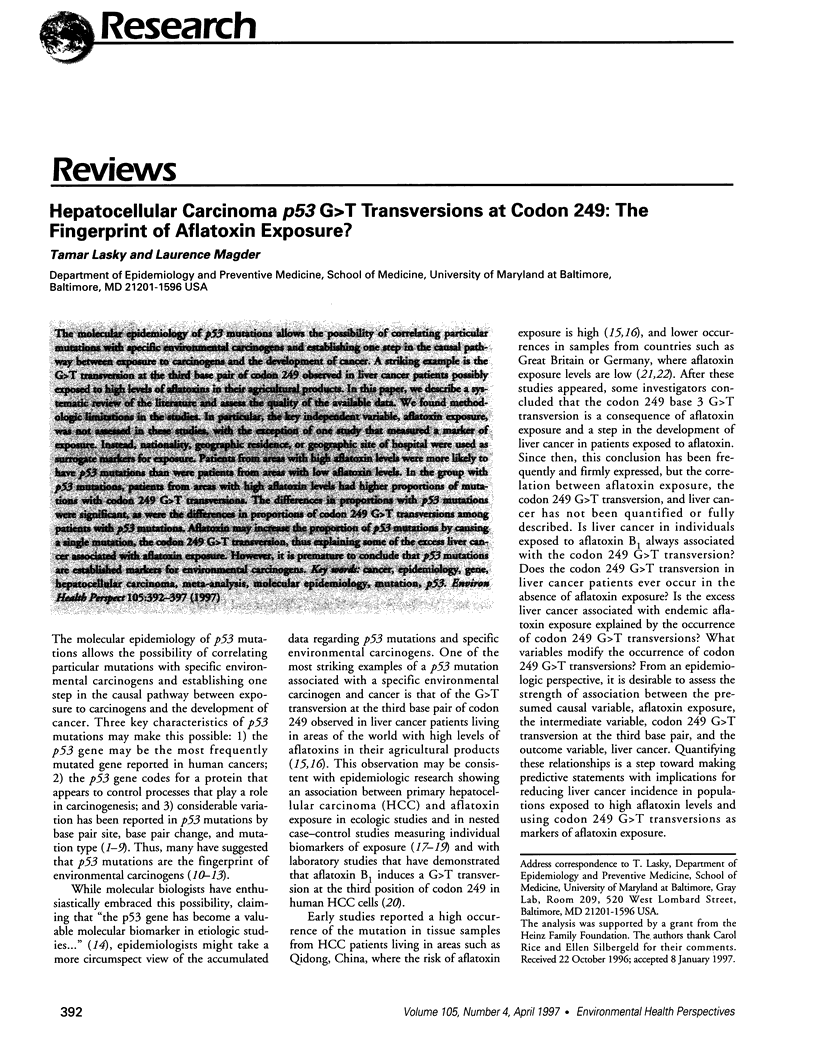
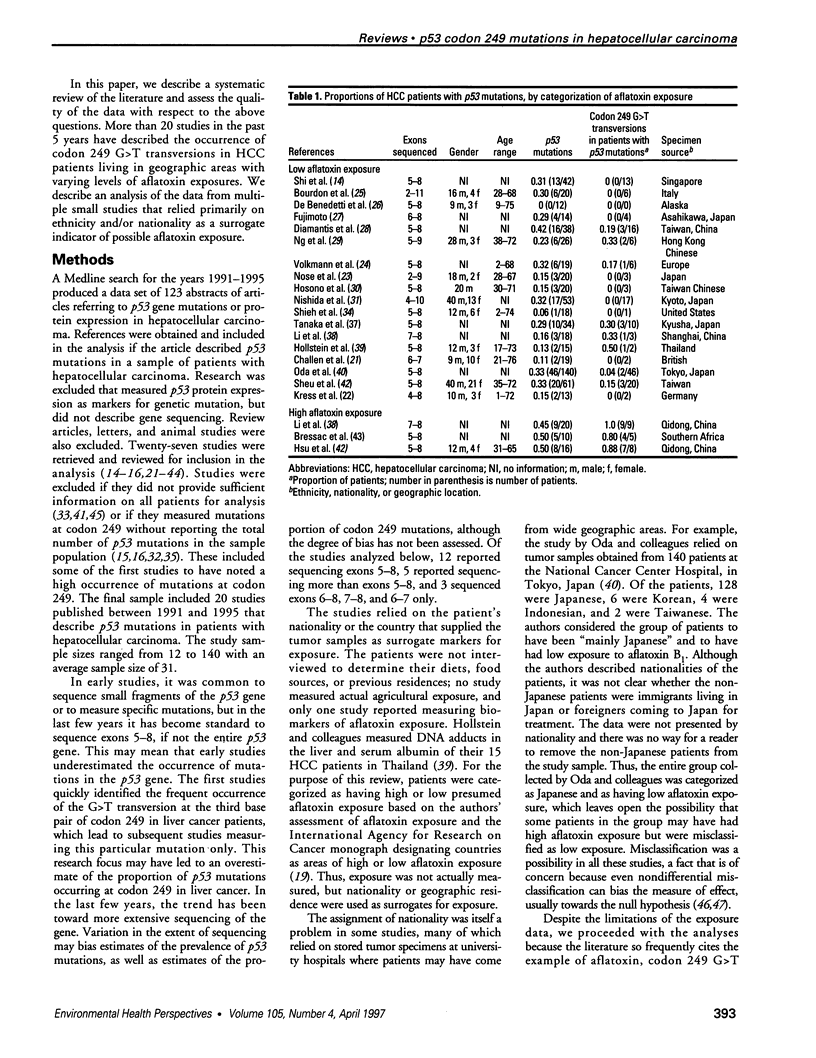
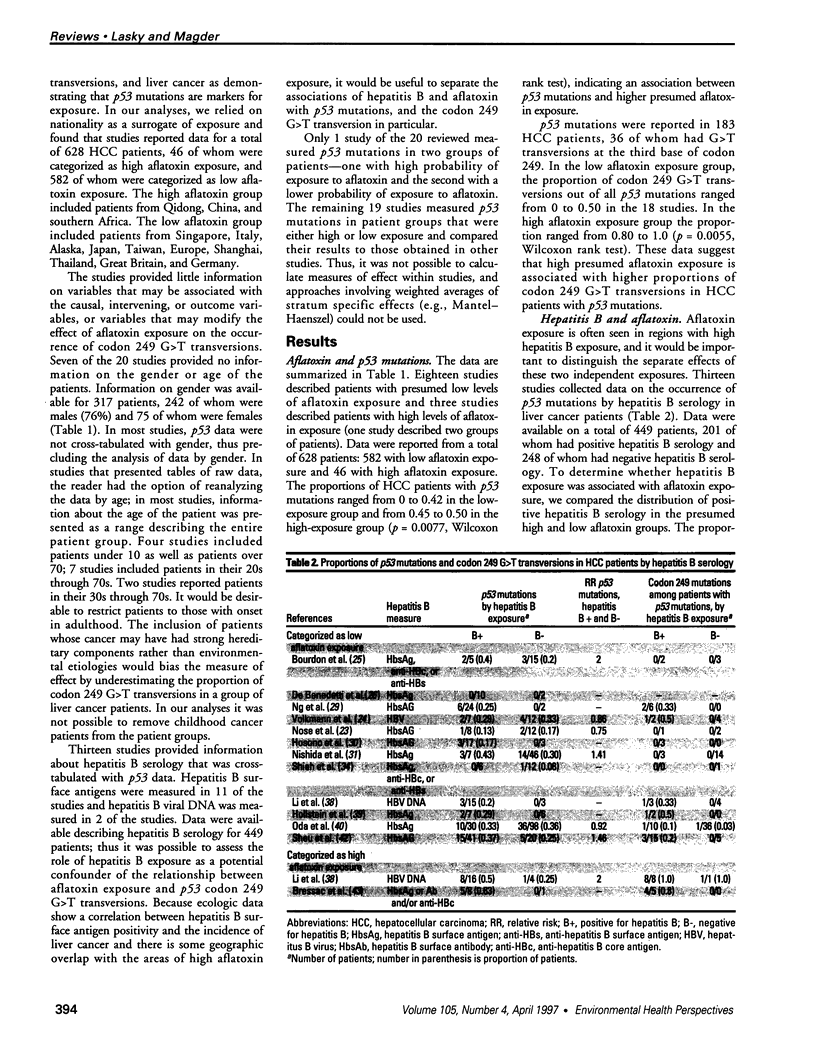
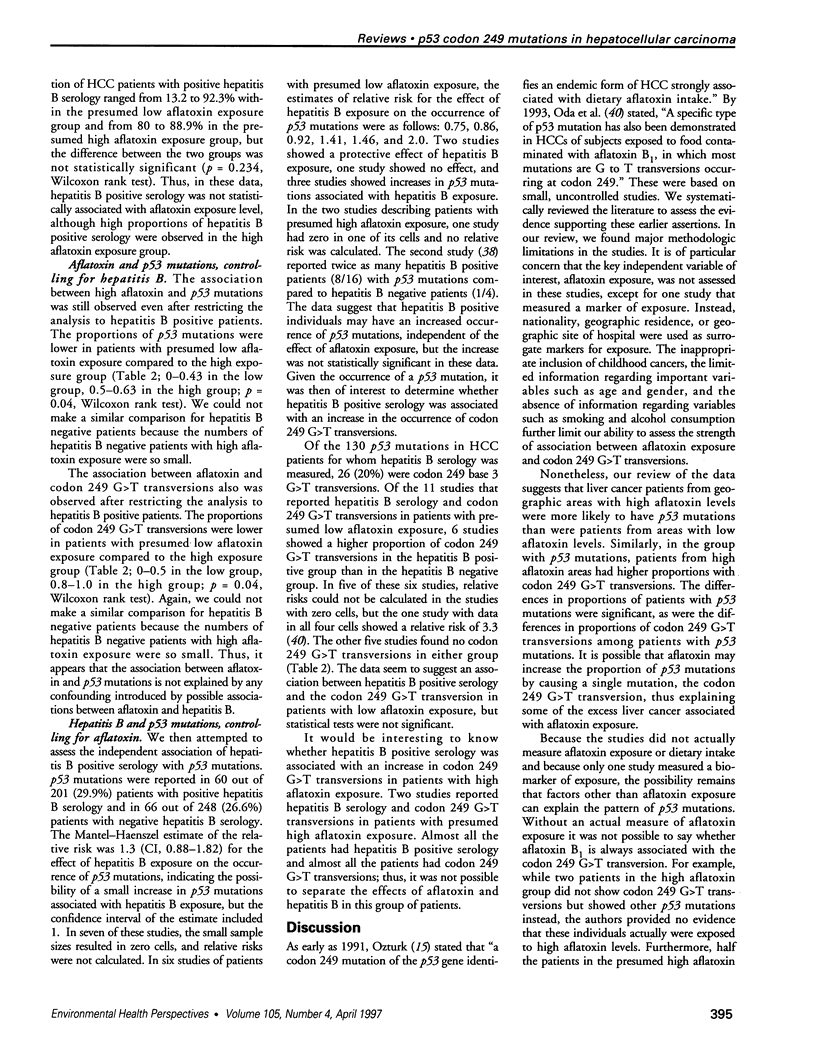
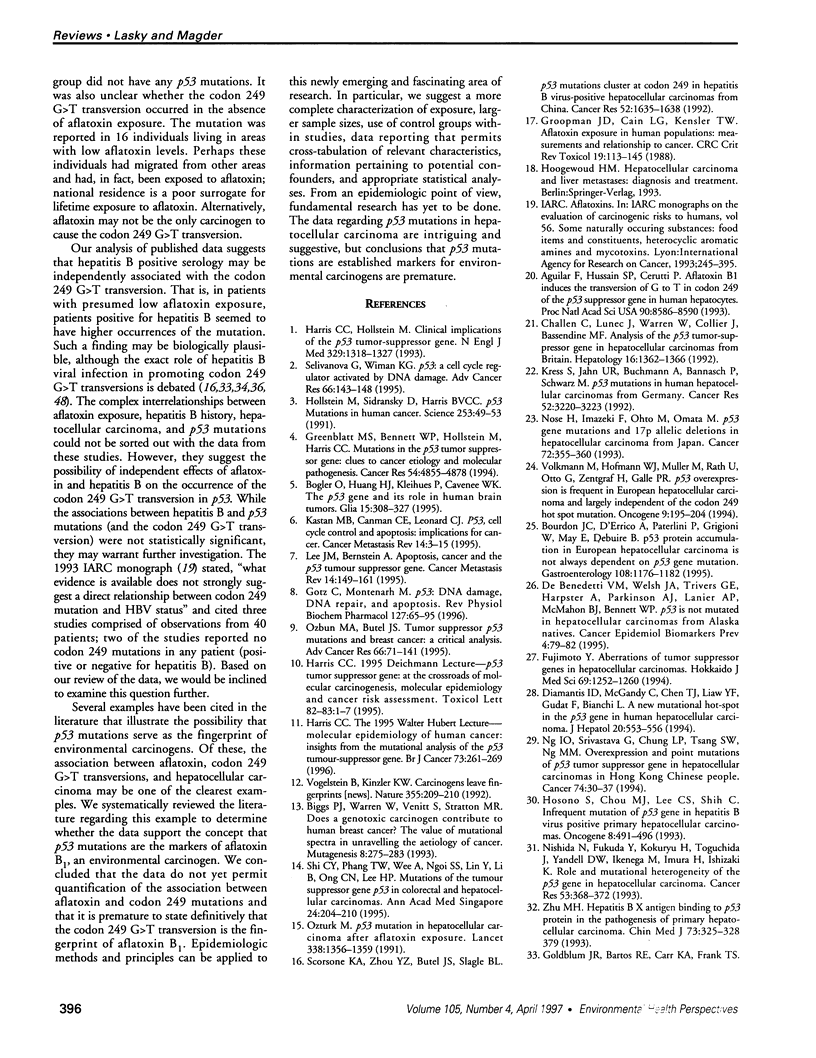
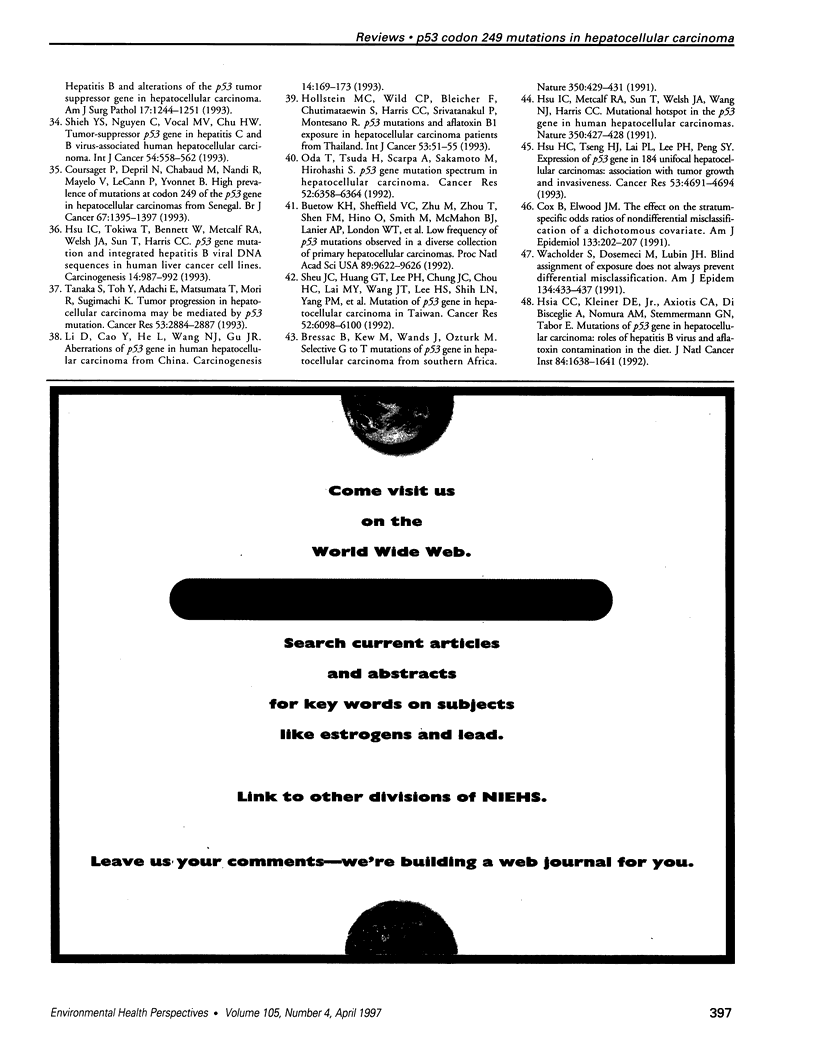
Images in this article
Selected References
These references are in PubMed. This may not be the complete list of references from this article.
- Aguilar F., Hussain S. P., Cerutti P. Aflatoxin B1 induces the transversion of G-->T in codon 249 of the p53 tumor suppressor gene in human hepatocytes. Proc Natl Acad Sci U S A. 1993 Sep 15;90(18):8586–8590. doi: 10.1073/pnas.90.18.8586. [DOI] [PMC free article] [PubMed] [Google Scholar]
- Biggs P. J., Warren W., Venitt S., Stratton M. R. Does a genotoxic carcinogen contribute to human breast cancer? The value of mutational spectra in unravelling the aetiology of cancer. Mutagenesis. 1993 Jul;8(4):275–283. doi: 10.1093/mutage/8.4.275. [DOI] [PubMed] [Google Scholar]
- Bourdon J. C., D'Errico A., Paterlini P., Grigioni W., May E., Debuire B. p53 protein accumulation in European hepatocellular carcinoma is not always dependent on p53 gene mutation. Gastroenterology. 1995 Apr;108(4):1176–1182. doi: 10.1016/0016-5085(95)90217-1. [DOI] [PubMed] [Google Scholar]
- Bressac B., Kew M., Wands J., Ozturk M. Selective G to T mutations of p53 gene in hepatocellular carcinoma from southern Africa. Nature. 1991 Apr 4;350(6317):429–431. doi: 10.1038/350429a0. [DOI] [PubMed] [Google Scholar]
- Buetow K. H., Sheffield V. C., Zhu M., Zhou T., Shen F. M., Hino O., Smith M., McMahon B. J., Lanier A. P., London W. T. Low frequency of p53 mutations observed in a diverse collection of primary hepatocellular carcinomas. Proc Natl Acad Sci U S A. 1992 Oct 15;89(20):9622–9626. doi: 10.1073/pnas.89.20.9622. [DOI] [PMC free article] [PubMed] [Google Scholar]
- Bögler O., Huang H. J., Kleihues P., Cavenee W. K. The p53 gene and its role in human brain tumors. Glia. 1995 Nov;15(3):308–327. doi: 10.1002/glia.440150311. [DOI] [PubMed] [Google Scholar]
- Challen C., Lunec J., Warren W., Collier J., Bassendine M. F. Analysis of the p53 tumor-suppressor gene in hepatocellular carcinomas from Britain. Hepatology. 1992 Dec;16(6):1362–1366. doi: 10.1002/hep.1840160610. [DOI] [PubMed] [Google Scholar]
- Coursaget P., Depril N., Chabaud M., Nandi R., Mayelo V., LeCann P., Yvonnet B. High prevalence of mutations at codon 249 of the p53 gene in hepatocellular carcinomas from Senegal. Br J Cancer. 1993 Jun;67(6):1395–1397. doi: 10.1038/bjc.1993.258. [DOI] [PMC free article] [PubMed] [Google Scholar]
- Cox B., Elwood J. M. The effect on the stratum-specific odds ratios of nondifferential misclassification of a dichotomous covariate. Am J Epidemiol. 1991 Jan 15;133(2):202–207. doi: 10.1093/oxfordjournals.aje.a115858. [DOI] [PubMed] [Google Scholar]
- De Benedetti V. M., Welsh J. A., Trivers G. E., Harpster A., Parkinson A. J., Lanier A. P., McMahon B. J., Bennett W. P. p53 is not mutated in hepatocellular carcinomas from Alaska Natives. Cancer Epidemiol Biomarkers Prev. 1995 Jan-Feb;4(1):79–82. [PubMed] [Google Scholar]
- Diamantis I. D., McGandy C., Chen T. J., Liaw Y. F., Gudat F., Bianchi L. A new mutational hot-spot in the p53 gene in human hepatocellular carcinoma. J Hepatol. 1994 Apr;20(4):553–556. doi: 10.1016/s0168-8278(05)80505-7. [DOI] [PubMed] [Google Scholar]
- Fujimoto Y. [Aberrations of tumor suppressor genes in hepatocellular carcinomas]. Hokkaido Igaku Zasshi. 1994 Sep;69(5):1252–1260. [PubMed] [Google Scholar]
- Goldblum J. R., Bartos R. E., Carr K. A., Frank T. S. Hepatitis B and alterations of the p53 tumor suppressor gene in hepatocellular carcinoma. Am J Surg Pathol. 1993 Dec;17(12):1244–1251. doi: 10.1097/00000478-199312000-00005. [DOI] [PubMed] [Google Scholar]
- Greenblatt M. S., Bennett W. P., Hollstein M., Harris C. C. Mutations in the p53 tumor suppressor gene: clues to cancer etiology and molecular pathogenesis. Cancer Res. 1994 Sep 15;54(18):4855–4878. [PubMed] [Google Scholar]
- Groopman J. D., Cain L. G., Kensler T. W. Aflatoxin exposure in human populations: measurements and relationship to cancer. Crit Rev Toxicol. 1988;19(2):113–145. doi: 10.3109/10408448809014902. [DOI] [PubMed] [Google Scholar]
- Götz C., Montenarh M. p53: DNA damage, DNA repair, and apoptosis. Rev Physiol Biochem Pharmacol. 1996;127:65–95. doi: 10.1007/BFb0048265. [DOI] [PubMed] [Google Scholar]
- Harris C. C., Hollstein M. Clinical implications of the p53 tumor-suppressor gene. N Engl J Med. 1993 Oct 28;329(18):1318–1327. doi: 10.1056/NEJM199310283291807. [DOI] [PubMed] [Google Scholar]
- Harris C. C. The 1995 Walter Hubert Lecture--molecular epidemiology of human cancer: insights from the mutational analysis of the p53 tumour-suppressor gene. Br J Cancer. 1996 Feb;73(3):261–269. doi: 10.1038/bjc.1996.47. [DOI] [PMC free article] [PubMed] [Google Scholar]
- Hollstein M. C., Wild C. P., Bleicher F., Chutimataewin S., Harris C. C., Srivatanakul P., Montesano R. p53 mutations and aflatoxin B1 exposure in hepatocellular carcinoma patients from Thailand. Int J Cancer. 1993 Jan 2;53(1):51–55. doi: 10.1002/ijc.2910530111. [DOI] [PubMed] [Google Scholar]
- Hollstein M., Sidransky D., Vogelstein B., Harris C. C. p53 mutations in human cancers. Science. 1991 Jul 5;253(5015):49–53. doi: 10.1126/science.1905840. [DOI] [PubMed] [Google Scholar]
- Hosono S., Chou M. J., Lee C. S., Shih C. Infrequent mutation of p53 gene in hepatitis B virus positive primary hepatocellular carcinomas. Oncogene. 1993 Feb;8(2):491–496. [PubMed] [Google Scholar]
- Hsia C. C., Kleiner D. E., Jr, Axiotis C. A., Di Bisceglie A., Nomura A. M., Stemmermann G. N., Tabor E. Mutations of p53 gene in hepatocellular carcinoma: roles of hepatitis B virus and aflatoxin contamination in the diet. J Natl Cancer Inst. 1992 Nov 4;84(21):1638–1641. doi: 10.1093/jnci/84.21.1638. [DOI] [PubMed] [Google Scholar]
- Hsu H. C., Tseng H. J., Lai P. L., Lee P. H., Peng S. Y. Expression of p53 gene in 184 unifocal hepatocellular carcinomas: association with tumor growth and invasiveness. Cancer Res. 1993 Oct 1;53(19):4691–4694. [PubMed] [Google Scholar]
- Hsu I. C., Metcalf R. A., Sun T., Welsh J. A., Wang N. J., Harris C. C. Mutational hotspot in the p53 gene in human hepatocellular carcinomas. Nature. 1991 Apr 4;350(6317):427–428. doi: 10.1038/350427a0. [DOI] [PubMed] [Google Scholar]
- Hsu I. C., Tokiwa T., Bennett W., Metcalf R. A., Welsh J. A., Sun T., Harris C. C. p53 gene mutation and integrated hepatitis B viral DNA sequences in human liver cancer cell lines. Carcinogenesis. 1993 May;14(5):987–992. doi: 10.1093/carcin/14.5.987. [DOI] [PubMed] [Google Scholar]
- Kastan M. B., Canman C. E., Leonard C. J. P53, cell cycle control and apoptosis: implications for cancer. Cancer Metastasis Rev. 1995 Mar;14(1):3–15. doi: 10.1007/BF00690207. [DOI] [PubMed] [Google Scholar]
- Kress S., Jahn U. R., Buchmann A., Bannasch P., Schwarz M. p53 Mutations in human hepatocellular carcinomas from Germany. Cancer Res. 1992 Jun 1;52(11):3220–3223. [PubMed] [Google Scholar]
- Lee J. M., Bernstein A. Apoptosis, cancer and the p53 tumour suppressor gene. Cancer Metastasis Rev. 1995 Jun;14(2):149–161. doi: 10.1007/BF00665797. [DOI] [PubMed] [Google Scholar]
- Li D., Cao Y., He L., Wang N. J., Gu J. R. Aberrations of p53 gene in human hepatocellular carcinoma from China. Carcinogenesis. 1993 Feb;14(2):169–173. doi: 10.1093/carcin/14.2.169. [DOI] [PubMed] [Google Scholar]
- Ng I. O., Srivastava G., Chung L. P., Tsang S. W., Ng M. M. Overexpression and point mutations of p53 tumor suppressor gene in hepatocellular carcinomas in Hong Kong Chinese people. Cancer. 1994 Jul 1;74(1):30–37. doi: 10.1002/1097-0142(19940701)74:1<30::aid-cncr2820740107>3.0.co;2-4. [DOI] [PubMed] [Google Scholar]
- Nishida N., Fukuda Y., Kokuryu H., Toguchida J., Yandell D. W., Ikenega M., Imura H., Ishizaki K. Role and mutational heterogeneity of the p53 gene in hepatocellular carcinoma. Cancer Res. 1993 Jan 15;53(2):368–372. [PubMed] [Google Scholar]
- Nose H., Imazeki F., Ohto M., Omata M. p53 gene mutations and 17p allelic deletions in hepatocellular carcinoma from Japan. Cancer. 1993 Jul 15;72(2):355–360. doi: 10.1002/1097-0142(19930715)72:2<355::aid-cncr2820720208>3.0.co;2-w. [DOI] [PubMed] [Google Scholar]
- Oda T., Tsuda H., Scarpa A., Sakamoto M., Hirohashi S. p53 gene mutation spectrum in hepatocellular carcinoma. Cancer Res. 1992 Nov 15;52(22):6358–6364. [PubMed] [Google Scholar]
- Ozbun M. A., Butel J. S. Tumor suppressor p53 mutations and breast cancer: a critical analysis. Adv Cancer Res. 1995;66:71–141. doi: 10.1016/s0065-230x(08)60252-3. [DOI] [PubMed] [Google Scholar]
- Ozturk M. p53 mutation in hepatocellular carcinoma after aflatoxin exposure. Lancet. 1991 Nov 30;338(8779):1356–1359. doi: 10.1016/0140-6736(91)92236-u. [DOI] [PubMed] [Google Scholar]
- Scorsone K. A., Zhou Y. Z., Butel J. S., Slagle B. L. p53 mutations cluster at codon 249 in hepatitis B virus-positive hepatocellular carcinomas from China. Cancer Res. 1992 Mar 15;52(6):1635–1638. [PubMed] [Google Scholar]
- Selivanova G., Wiman K. G. p53: a cell cycle regulator activated by DNA damage. Adv Cancer Res. 1995;66:143–180. doi: 10.1016/s0065-230x(08)60253-5. [DOI] [PubMed] [Google Scholar]
- Sheu J. C., Huang G. T., Lee P. H., Chung J. C., Chou H. C., Lai M. Y., Wang J. T., Lee H. S., Shih L. N., Yang P. M. Mutation of p53 gene in hepatocellular carcinoma in Taiwan. Cancer Res. 1992 Nov 1;52(21):6098–6100. [PubMed] [Google Scholar]
- Shi C. Y., Phang T. W., Wee A., Ngoi S. S., Lin Y., Li B., Ong C. N., Lee H. P. Mutations of the tumour suppressor gene p53 in colorectal and hepatocellular carcinomas. Ann Acad Med Singapore. 1995 Mar;24(2):204–210. [PubMed] [Google Scholar]
- Shieh Y. S., Nguyen C., Vocal M. V., Chu H. W. Tumor-suppressor p53 gene in hepatitis C and B virus-associated human hepatocellular carcinoma. Int J Cancer. 1993 Jun 19;54(4):558–562. doi: 10.1002/ijc.2910540407. [DOI] [PubMed] [Google Scholar]
- Tanaka S., Toh Y., Adachi E., Matsumata T., Mori R., Sugimachi K. Tumor progression in hepatocellular carcinoma may be mediated by p53 mutation. Cancer Res. 1993 Jun 15;53(12):2884–2887. [PubMed] [Google Scholar]
- Vogelstein B., Kinzler K. W. Carcinogens leave fingerprints. Nature. 1992 Jan 16;355(6357):209–210. doi: 10.1038/355209a0. [DOI] [PubMed] [Google Scholar]
- Volkmann M., Hofmann W. J., Müller M., Räth U., Otto G., Zentgraf H., Galle P. R. p53 overexpression is frequent in European hepatocellular carcinoma and largely independent of the codon 249 hot spot mutation. Oncogene. 1994 Jan;9(1):195–204. [PubMed] [Google Scholar]
- Wacholder S., Dosemeci M., Lubin J. H. Blind assignment of exposure does not always prevent differential misclassification. Am J Epidemiol. 1991 Aug 15;134(4):433–437. doi: 10.1093/oxfordjournals.aje.a116105. [DOI] [PubMed] [Google Scholar]
- Zhu M. H. [Hepatitis B X antigen binding to p53 protein in the pathogenesis of primary hepatocellular carcinoma]. Zhonghua Yi Xue Za Zhi. 1993 Jun;73(6):325-8, 379. [PubMed] [Google Scholar]



